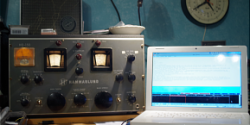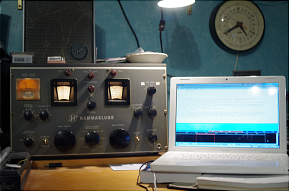Looks like the Voice of America radiogram project is super busy these days, running lots of trials with text messaging via short wave streams. When last Radio Survivor checked in on the initiative, we stopped to admire a 1938 Philco radio console rigged by a short wave operator to pick up VOA radiograms. Now there’s more old receiver fun coming from the operation. Below right admire a 1950s era Hammarlund HQ-150 receiver plugged into a PC to pick up radiogram transmissions.
The point? These short wave text streams could come in handy during huge emergencies (see Philippenes typhoon) or to end run Internet censorship by authoritarian governments.
Speaking of the latter, the radiogram team recently ran some transmissions in Chinese:
“When we last transmitted Chinese characters on VOA Radiogram, we noted that they printed out more slowly than English letters,” a blog post noted. “This is no doubt due to the greater complexity of the code involved with non-Latin alphabets. This weekend we will transmit Chinese characters in MFSK32, then try to speed it up with MFSk64. Make sure you have Fldigi set to the UTF-8 character set.”
A rough translation for that last sentence:
“MFSK” means the multi-frequency key shifting method—a carrier wave system for text run on more than two frequencies. 32 and 64 represent two different MFSK mode speeds. “Fldigi” is a digital modem program accessible via Linux and Free-BSD (also OS X, Windows XP, NT, W2K, Vista and Win7). And the UTF-8 character set is an 8 bit version of Unicode, the computer encoded text standard that extends to most written languages around the globe.
Here’s a YouTube of a receiver that picked up the text (Mandarin), plus some images.




